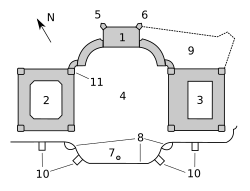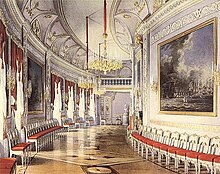Gatchina Castle
Gatchina Palace ( Russian Большой Гатчинский дворец ) is a palace complex in the city of Gatchina , 45 kilometers south of Saint Petersburg in Russia. The area originally built under Count Orlow and expanded by the Tsars was an important facility of its time.
history
In 1765, Empress Catherine the Great gave the village to her favorite, Count Grigory Grigoryevich Orlov , who had the castle built with 600 rooms. For the first time in Russia this was surrounded by an English garden . The architect Antonio Rinaldi had a large triumphal arch built at the entrance to the park between 1777 and 1782. The interior of the castle is in the classical style and was designed by Antonio Rinaldi and Vincenzo Brenna . Italian plasterers and Russian craftsmen created the appropriate interior design with ceiling paintings, parquet floors and Italian furniture.
When Count Orlov died in 1783, the Empress bought the castle by his heirs and gave it to her son, the future Emperor Paul I on. He made changes in the neoclassical style in the 1790s and had several bridges and pavilions built in the park. After Paul's death, the castle was initially largely unused. It was not until Alexander III. then made it an imperial residence again. The last Russian emperor , Nicholas II , spent his youth here; after his abdication in 1917 he was temporarily placed under house arrest in Gatchina. Then the castle was converted into a museum .
Shortly after the start of the German-Soviet War on June 22, 1941, the castle was occupied by Wehrmacht troops. When the castle was looted by Reichsleiter Rosenberg's task force , a secret room is said to have been found which was furnished with various erotic furniture and works of art. Whether these works of art and furniture were produced and used under Catherine the Great or whether they are historicizing pieces from a later epoch could not be determined with absolute certainty. However, the whereabouts of these objects is unclear after the Second World War.
In the course of their Leningrad-Novgorod operation , the Red Army captured the place in early 1944 and when the German troops withdrew, the castle was devastated and set on fire.
The exterior of the castle was restored after the war. The reconstruction of all interior rooms has not yet been completed.
See also
Web links
- Web presence of Gatchina Castle (Russian / English)
Individual evidence
- ↑ In the love nest of the tsaresses. A castle near St. Petersburg contained a pornographic rarity. Spiegel Online, December 11, 2000, accessed March 19, 2017 .
Coordinates: 59 ° 33 ′ 48 ″ N , 30 ° 6 ′ 27 ″ E


